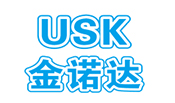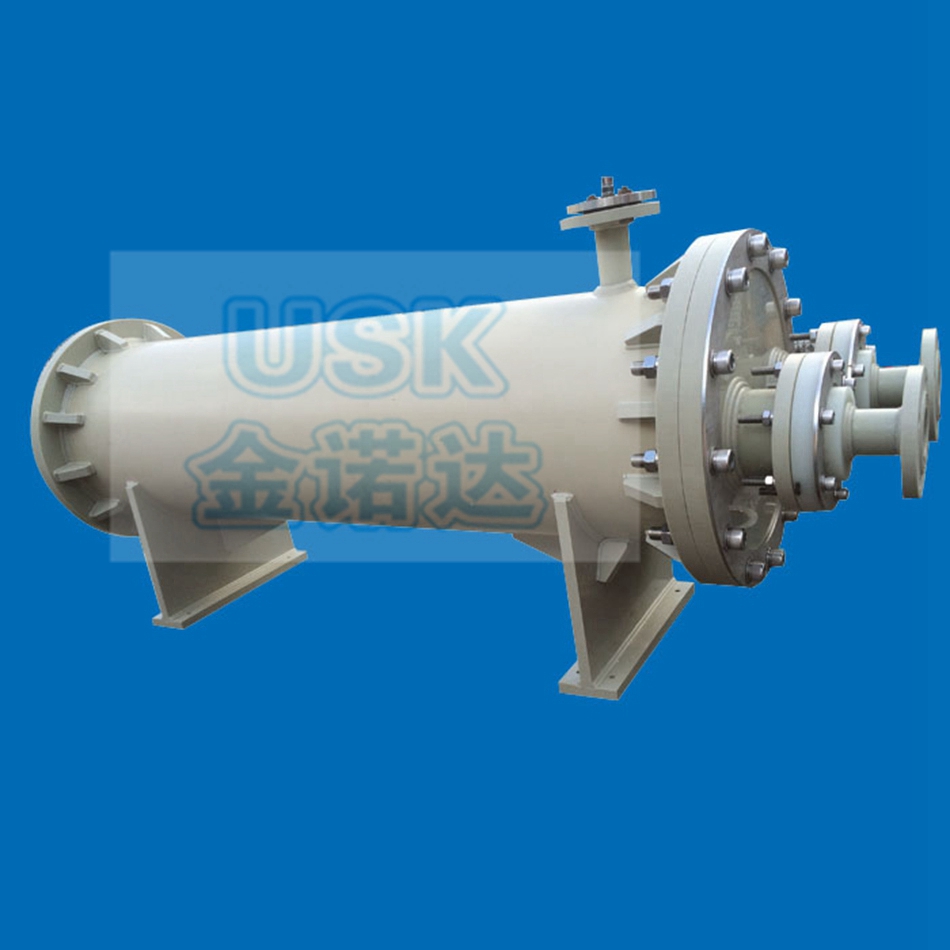
Working principle of structural performance of shell Teflon heat exchanger
- Categories:Recommend
- Author:Kinoda
- Origin:Jinnuoda Engineering
- Time of issue:2017-08-21 00:00
- Views:
Working principle of structural performance of shell Teflon heat exchanger

Structure type:
The plastic heat exchange thin tubes (Φ3, Φ4, Φ5, Φ6, Φ9) are made into tube bundle coiled (or column tube) heat exchange cores (tube side), and placed in plastic (or steel) simplified In the (shell side), the end is fastened and sealed with a flange cover plate, and the entire cylinder is placed on a vertical (or horizontal) base, which is made of fluoroplastic (PEA, FEP, PTFE) tube bundle and flange as a whole by heat shrinkage The inner core of the heat exchanger and the outer body of the heat exchanger are equipped with a baffle device, and pipe inlet and outlet flanges for the fluid inlet and outlet of the pipe side and the shell side are opened at appropriate locations to form an individual tube and shell heat exchanger. The heat exchanger for chemical industry is designed and manufactured according to chemical standards.
working principle:
During heating, steam (hot water, thermal oil) is passed through the tube side, the solution to be heated is pumped into the shell side, heat exchange is performed through the surface of the tube bundle, and circulation is continued until the solution is heated to the working temperature and maintained.
During cooling, the tube side passes refrigerant water (well water, tap water, frozen water), the solution to be cooled is pumped into the shell side, heat exchange is performed through the surface of the tube bundle, and circulation is continued until the solution is cooled to the working temperature and maintained.
Features:
The original coiled cylindrical heat exchange core, hundreds of thin tubes in the base heat exchange tube bundle, are close in length, equally spaced, layer-by-layer coiled, evenly distributed, compact in structure, but have the largest heat exchange in a certain column space The area, using this heat exchange core as a shell-and-tube heat exchanger made in the tube side, has the characteristics of high heat exchange efficiency, fast speed, small product and good energy saving effect.
Scope of application:
Suitable for electroplating, electrolysis, degreasing, pickling, strip pickling, phosphoric acid purification, electroless nickel-phosphorus plating, anodizing, aluminum porosity, smelting, chemical industry, medicine, food and other corrosive liquid phase heating, condensation, evaporation, Concentrate etc.
The main technical parameters:
The shell-and-tube heat exchanger is also called a tube-and-tube heat exchanger (the shell and tube are made of PP, stainless steel and carbon steel, lined with PTFE or PO). It is a partition wall heat exchanger with the wall surface of the tube bundle enclosed in the shell as the heat transfer surface. This heat exchanger has a simple structure, reliable operation, can be manufactured with various structural materials, and can be used under high temperature and high pressure. It is the most widely used type at present. Fluoroplastic shell and tube heat exchangers have advantages over traditional metal shell and tube heat exchangers
mainly reflects in:
Fluoroplastic chemical properties very stable, good corrosion resistance, more resistant to heat, pressure, corrosion
smooth wall surface of fluoroplastic, and has moderate flexibility, slight vibration during use, it is easy to scale
fluoroplastic heat The volume is small, the structure is compact, the heat exchange area is large, the heat exchange efficiency is high, and the installation and transportation are convenient
. The flexible fluoroplastic tube of the fluoroplastic heat exchanger body can work safely under the impact and vibration of the fluid.
Fluoroplastics of various shapes are inherently non-sticky and self-cleaning. Therefore, heat exchangers made of fluoroplastics have a certain self-cleaning function. At the same time, the fluoroplastic tube bundle is light in weight and will have slight vibration when used. There will be too many crystals attached to the tube bundle.
The surface of the fluoroplastic heat exchange tube itself is smooth, and the friction coefficient is small, and the fluoroplastic heat exchange tube is rich in elasticity compared to the metal heat exchange tube.
Fluoroplastic heat exchangers have become a very ideal material due to their good thermal stability, flexibility, crack resistance and transparency; after normal heating, they still maintain their original characteristics, even at low temperatures of -240 ℃ It can exert its characteristics and does not react with almost all products. It has the superior characteristics of typical fluoropolymers. For example, industrial chemicals and solvents adjusted at 260 ℃ produce chemical reactions, which have significant non-conductivity and stable frequency and temperature. Its products have appropriate hardness and high ultimate ductility.
The equipment manufacturing standards are as follows:
* Equipment and pipe fittings must be derusted before rotomolding, to remove welding slag and oil and other contaminants, to achieve clean and dust-free, and then use compressed air to blow the inner surface of the equipment and pipe fittings multiple times.
* The equipment is made of stainless steel with a thickness of 4-7 mm. Special circumstances can be increased or decreased according to user requirements.
* After the equipment is lined, use electric spark micro-hole detection. At an output voltage of 5KV-30KV, the probe is detected at a moving speed of no more than 50mm / s on the anticorrosive lining layer, and it is qualified if it does not break down.
* Equipment manufacturing and acceptance specifications are in accordance with HGJ45-90 standard and HGJ33-90 standard
* Equipment and pipe flanges are prepared in accordance with HGJ45-91 standard or GB11935-89 standard, special requirements are prepared separately
* Equipment welding specifications are in accordance with JB / T4709-92 standard, Equipment welding requirements
are as follows: GB985-88 standard * Rubber technical requirements are as follows: DN25-DN100, R ≥ 3-6 mm, DN100-DN200, R ≥ 6-8 mm; DN250-DN600, R ≥ 8-10 mm; DN600 above , R≥10-12 mm.
* The equipment paint is executed according to standard JB2536-80; it is higher than the national standard enterprise standard.
Copyright © 2020 Shenzhen jinnuoda Teflon electrothermal Technology Co., Ltd. 粤ICP备12092087号



